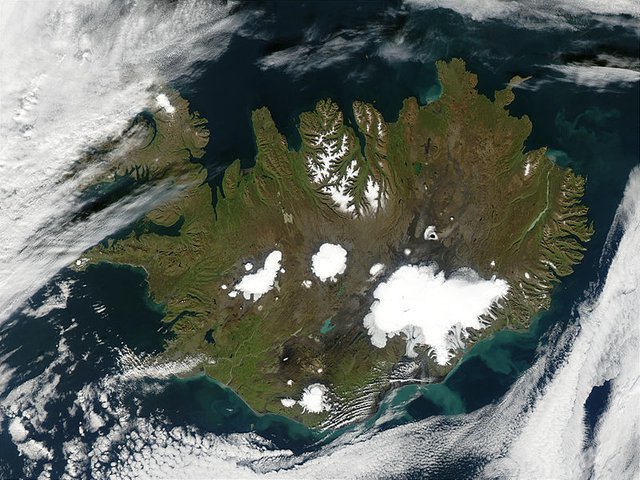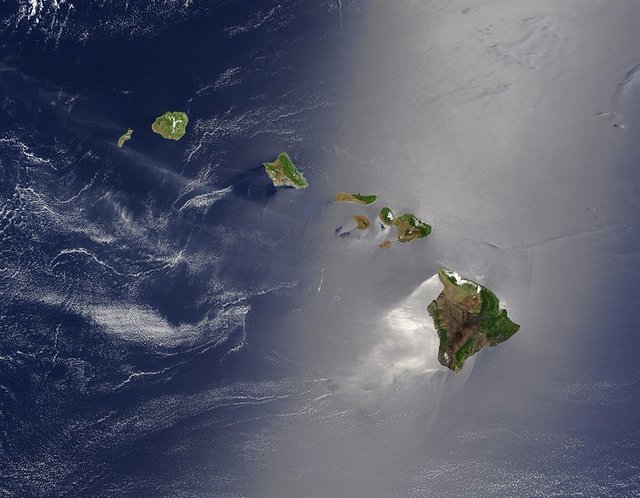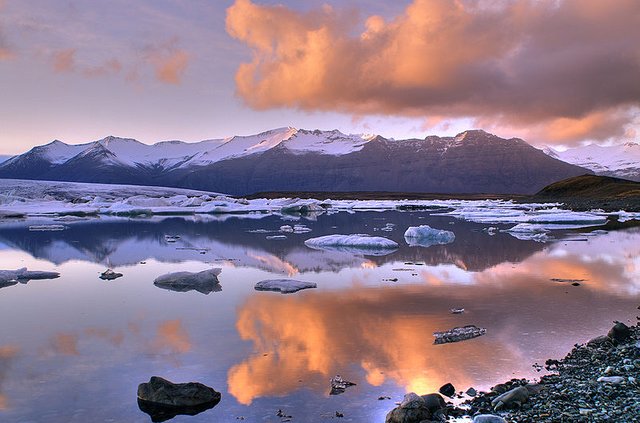Spaghetti on the road – Iceland, a song of ice and fire
As Michael Crichton wrote, to which many of us owe the birth of deep interest in the natural world through books such as Jurassic Park and Andromeda, "Professor Johnston often said that if you did not know the story, you knew nothing. You were a leaf that did not know you were part of a tree".
Wanting to be fully aware of the tree we are part of, we can not help but go deeper into the history of that remote corner of the Earth to which we will leave in a few days.
In fact, Iceland does not only present breathtaking views, exotic animals and impressive manifestations of the forces that act within the earth, but is the protagonist of a natural history almost unique in its kind, of which we hope to be able to feel part of once arrived on site, and to be able to transmit through daily reports.

Image Public Domain – Source
This land, unlike the other large islands that characterize Europe such as Sicily, Great Britain, Sardinia, Ireland and Corsica, does not represent a portion of continental crust that has moved away from the continental mass of the tectonic movements of the plates it was part (for example, Corsica and Sardinia, before being in the current position, were merged with the south of France and part of Spain). Its origin is much closer to that of archipelagos such as Hawaii or the Galapagos that are generated by the ascent of magma from areas below the asthenosphere (the portion of the mantle on which the plates of the earth's crust float and move). These places, where the deep magma rises, are called hot spots and remain fixed in time while the crust floating on the asthenosphere moves to produce a sequence of islands that will go from the oldest to the last formed. The arch formation of the Hawaiian islands is typical of this process.

Image Public Domain – Source
Typical arch formation of the Hawaiian Islands.
Although Iceland owes its formation to events of this kind, it has a trait that makes it unique in the world: it comes from the incredible meeting of a hot spot with the Atlantic Oceanic Dorsal.
The ridges are faults systems from which magmatic material continually emerges. The production is such as to generate some reliefs at the bottom of the sea, even 3000 meters high. Iceland, therefore, represents an area of the earth's crust where the magma spill is such that it has allowed the emergence of a huge area well above sea level. Being also excluded from the movements of the plates (in reality the backbones can be closed) the underlying hot point does not generate the typical arched structures with ever younger islands, but collaborates in the formation of a large island in continuous growth.
Obviously, Iceland presents many traces of this enormous generating force, and we will do our best to try to impress it in our photos and tie it to our posts, so that it can be an indelible memory for us and a valuable tool for those who will accompany us from behind a monitor.
If you could capture an image of the Atlantic Ocean with highlights of the faults that make up the Mid-Atlantic Ridge, you would realize that this does not end when it meets the earth, but continues on its surface in the form of a very large valley with walls steep (another example of constructive margin on the emerged land is the African Rift Valley).
Geologically speaking, Iceland is therefore divided in two by the backbone, and this leads to surprising consequences to say the least. In fact, crossing the great valley you are on two completely different plates. The western part of the island is part of the American plate, while the eastern part is part of the Eurasian plate.
Another consequence linked to the continuous solidification of magma that emerges from the backbone (and the hot point) is that Iceland is constantly expanding, so as to expand at a speed similar to that of the ocean floor. The most accurate estimates predict an increase of one centimeter per year, which might seem like little if compared to human measures, but is a huge number in terms of geological eras.
Image Public Domain – Source
Besides the large ridge that runs along the entire Icelandic surface, like a scar, from the southwest to the northeast, there are other important signs of the forces that contributed to the formation of this marvelous island. It is possible to count a large number of volcanoes, which characterize both the ridges and, more generally, the margins between plates, and an even more surprising number of geysers. These secondary volcanism phenomena are due to a particular geological condition: in order for the geyser to manifest itself, it is necessary that some rocks permeable to water are embedded in impermeable rocks, and that the whole formation is near a magma chamber. When the water percolates inside the rocks and goes deep down it is heated by the presence of the underlying magma, but due to the lithostatic pressure it does not turn into steam and is pushed upwards, freeing a jet of water and steam that can arrive to even touch the 170 meters in height.
Due to the presence of these elements, Iceland appears to us as a primitive earth able to bring us back to the dawn of the history of our planet. None of us would be hard pressed to believe that it is one of the most ancient places on the planet. Yet, by doing so, we would all fall into error, because this magnificent island is instead one of the youngest places on the planet. Its emergence, in fact, began just over 20 million years ago.
We talked about a land dominated and shaped by fire, but another element played a fundamental role in the formation of this territory: ice.
Since the Pleistocene (3 million years ago) Iceland has been strongly influenced by the glaciations, a periodic phenomenon that involves a period of general cooling of the earth's surface (we speak tens of thousands of years) with the consequent advance of the ice. Between one glaciation and the other, we have the interglacial periods (the current one) during which the ice tend to retreat at more extreme latitudes.
Iceland is doubtlessly one of the European regions most marked by this phenomenon of advancing the ice so much so that it still bears the mark of the past glaciation in the form of the great perennial glacier that occupies its central portion (another territory presenting these signs is Greenland, with the largest land mass ice on the northern hemisphere).
This continuous advance and ice retreat on the Icelandic surface has shaped the life in this territory in an important way that in fact presents a general lack of flora and fauna (of which even man is guilty) typical of the areas that have suffered a strong influence from the glaciations.

Image CC BY 2.0 – Source
Undoubtedly, Iceland is a land that is out of the ordinary, surprising for the continuous succession of contrasts and contrasts that make it full of mystery and charm.
A young land, which, however, presents many traits able to bring us back in time, up to the formation of the earth's crust. A land forged by fire and reshaped by ice, rich in things to tell, but also secrets to keep.

Spaghetti on the road - Islanda, cronache del ghiaccio e del fuoco
Come scriveva Michael Crichton, a cui molti di noi devono la nascita del profondo interesse verso il mondo naturale grazie a libri come Jurassic Park e Andromeda, “Il professor Johnston diceva spesso che se non sapevi la storia, non sapevi nulla. Eri una foglia che non sapeva di essere parte di un albero”.
Volendo essere pienamente consci dell’albero di cui facciamo parte, non possiamo fare altro che addentrarci profondamente nella storia di quell’angolo remoto della Terra verso il quale partiremo tra pochi giorni.
L’Islanda, infatti, non presenta solamente panorami mozzafiato, animali esotici e impressionanti manifestazioni delle forze che agiscono all’interno della terra, ma è protagonista di una storia naturale pressoché unica nel suo genere, di cui speriamo di riuscire a sentirci parte una volta giunti in loco, e di riuscire a trasmettere attraverso i report giornalieri.

Image Public Domain – Source
Questa terra, a differenza delle altre grandi isole che caratterizzano l’Europa come Sicilia, Gran Bretagna, Sardegna, Irlanda e Corsica, non rappresenta una porzione di crosta continentale che attraverso i movimenti legati alla tettonica delle placche si è allontanata dalla massa continentale di cui faceva parte (per esempio la Corsica e la Sardegna, prima di trovarsi nella posizione attuale, erano fuse con il sud della Francia e parte della Spagna). La sua origine è molto più vicina a quella di arcipelaghi come le Hawaii o le Galapagos che sono generate dalla risalita di magma da zone sottostanti l’astenosfera (la porzione di mantello su cui galleggiano e si muovono le placche della crosta terrestre). Questi luoghi, in cui avviene la risalita di magma profondo, vengono chiamati punti caldi e rimangono fissi nel tempo mentre la crosta che galleggia sull’astenosfera si muove producendo una sequenza di isole che andranno dalla più vecchia all’ultima formata. La formazione ad arco delle isole Hawaii è tipica di questo processo.

Image Public Domain – Source
Tipica formazione ad arco delle Isole Hawaii.
Nonostante l’Islanda debba la propria formazione a eventi di questo tipo, possiede un tratto che la rende unica al mondo: essa nasce dall’incredibile incontro di un punto caldo con la Dorsale Oceanica Atlantica.
Le dorsali sono dei sistemi di faglie da cui fuoriesce continuamente materiale magmatico. La produzione è tale da generare dei rilievi sul fondo del mare alti anche 3000 metri. L’Islanda, quindi, rappresenta una zona della crosta terrestre dove la fuoriuscita di magma è tale da aver permesso l’emersione di un enorme area ben al di sopra del livello del mare. Essendo inoltre escluso dai movimenti delle placche (in realtà le dorsali si possono chiudere) il punto caldo sottostante non genera le tipiche strutture ad arco con isole sempre più giovani, ma collabora alla formazione di una grande isola in continuo accrescimento.
Ovviamente, l’Islanda presenta moltissime tracce di questa enorme forza generatrice, e faremo del nostro meglio per cercare di imprimerla nelle nostre foto e di legarla ai nostri post, in modo che possa essere un ricordo indelebile per noi e uno prezioso strumento per chi ci accompagnerà da dietro un monitor.
Se si riuscisse a catturare un’immagine dell’Oceano Atlantico con in evidenza le faglie che costituiscono la Dorsale Medio Atlantica, ci si renderebbe conto che questa non finisce quando incontra la terra, bensì continua sulla sua superfice sotto forma di una grandissima valle con pareti scoscese (un altro esempio di margine costruttivo sulla terra emersa è la Rift Valley africana).
Geologicamente parlando, l’Islanda risulta quindi divisa in due dalla dorsale, e questo porta a delle conseguenze a dir poco sorprendenti. Infatti, attraversando la grande vallata ci si trova su due placche completamente differenti. La parte occidentale dell’isola fa parte della placca americana, mentre quella orientale fa parte della placca euroasiatica.
Un’altra conseguenza legata alla continua solidificazione di magma che fuoriesce della dorsale (e del punto caldo) è che l’Islanda è in continua espansione, tanto da espandersi ad una velocità simile a quella dei fondali oceanici. Le stime più accurate prevedono un accrescimento di un centimetro all’anno, che potrebbe sembrare poca cosa se rapportato alle misure umane, ma risulta un numero enorme in termini di ere geologiche.
Image Public Domain – Source
Oltre alla grande dorsale che come una cicatrice corre lungo tutta la superficie islandese, da sud ovest a nord est, sono presenti altri importanti segni delle forze che hanno contribuito alla formazione di quest’isola meravigliosa. È possibile contare un elevato numero di vulcani, che caratterizzano sia le dorsali che più in generale i margini fra placche, ed un ancor più sorprendente numero di geyser. Questi fenomeni di vulcanismo secondario sono dovuti ad una particolare condizione geologica: affinché il geyser su manifesti, è necessario che delle rocce permeabili all’acqua siano incassate in rocce impermeabili, e che l’intera formazione sia nei pressi di una camera magmatica. Quando l’acqua percola all’interno delle rocce e scende in profondità viene scaldata dalla presenza del magma sottostante, ma a causa della pressione litostatica non si trasforma in vapore e viene spinta verso l’alto liberando un getto di acqua e vapore che può arrivare a toccare anche i 170 metri di altezza.
Proprio per la presenza di questi elementi, l’Islanda ci appare come una terra primitiva in grado di riportarci agli albori della storia del nostro pianeta. Nessuno di noi faticherebbe a credere che sia uno dei luoghi più antichi del pianeta. Eppure, così facendo, cadremmo tutti insieme in errore, perché questa magnifica isola è invece uno dei luoghi più giovani del pianeta. La sua emersione, infatti, ha avuto inizio poco più di 20 milioni di anni fa.
Abbiamo parlato di una terra dominata e plasmata dal fuoco, ma un altro elemento ha giocato un ruolo fondamentale nella formazione di questo territorio: il ghiaccio.
A partire dal Pleistocene (3 milioni di anni fa) l’Islanda è stata fortemente influenzata dalle glaciazioni, un fenomeno periodico che comporta un periodo di generale raffreddamento della superficie terrestre (si parla di decine di migliaia di anni) con conseguente avanzata dei ghiacci. Fra una glaciazione e l’altra abbiamo i periodi interglaciali (quello attuale) durante i quali i ghiacci tendono a ritirarsi a latitudini più estreme.
L’Islanda è in dubbiamente una delle regioni europee maggiormente segnate da questo fenomeno di avanzamento dei ghiacci tanto da portare ancora il segno della passata glaciazione sotto forma del grande ghiacciaio perenne che ne occupa la porzione centrale (un altro territorio che presenta questi segni è la Groenlandia, con la più grande massa di ghiaccio su terraferma dell’emisfero nord).
Questa continua avanzata e ritirata dei ghiacci sulla superficie islandese ha plasmato in maniera importante la vita in questo territorio che infatti presenta una generale scarsità di flora e fauna (di cui è comunque colpevole anche l’uomo) tipica delle aree che hanno subito un forte influsso da parte delle glaciazioni.

Image CC BY 2.0 – Source
L’Islanda rappresenta senza dubbio alcune una terra fuori dal comune, che sorprende per il continuo susseguirsi di contrasti e contrapposizioni che la rendono colma di mistero e fascino.
Una terra giovane, che presenta però numerosi tratti in grado di riportarci indietro nel tempo, fino alla formazione della crosta terrestre. Una terra forgiata dal fuoco e rimodellata dal ghiaccio, ricca di cose da raccontare, ma anche di segreti da custodire.

Immagine CC0 Creative Commons, si ringrazia @mrazura per il logo ITASTEM.
CLICK HERE AND VOTE FOR DAVINCI.WITNESS
References
- Ólafur Ingólfsson. A Review of the Late Weichselian and Early Holocene Glacial and Environmental History of Iceland.
https://doi.org/10.1007/978-94-011-3150-6_2 - T. Einarsson, K. J. Albertsson. The glacial history of Iceland during the past three million years.
https://doi.org/10.1098/rstb.1988.0027 - Agust Gudmundsson. Formation and growth of normal faults at the divergent plate boundary in Iceland.
https://doi.org/10.1111/j.1365-3121.1992.tb00582.x

Logo creato da @ilvacca
Iceland is definitely on my bucket list. Especially for the aurora borealis, which I understand is beautiful and intense in Iceland.
Yes it is. Unfortunately for the next decade will be a show a bit 'more difficult to observe, since the sun has entered its phase of minimal activity.
When I visited Iceland a few years ago, the place was so different from other parts of the world that it felt like I was on a different planet at times. Primitive/ancient are good words to describe it. Thanks for explaining some of the forces that created this awesome place.
"A different planet" is the most used expression to describe this wonderful place... And I think it perfectly matches the idea... Few other places in the world can be compared to Iceland ...
Voglio la foto della zona dove si dividono le placche, dorsale medioatlantica. Un piede su una placca e un piede sull'altra.
Un saluto, nicola
Assolutamente una delle cose che abbiamo intenzione di fare!
Hai realizzato un post fantastico; quello dell'Islanda è un territorio spettacolare che propone spettacoli bizzarri, si passa dalle altissime temperature che dal punto caldo partono fino a raggiungere la superficie del mare, poi si passa a periodi dove le temperature sono glaciali, sulla superficie si vedono anche fenomeni come i geyser che arrivano anche a 170 metri; insomma spettacoli naturali che farebbero invidia anche ai miglior effetti speciali film di ultima generazione!
Hai esposto il tutto con grande chiarezza, rendendo il testo di facile comprensione, ti meriti i più grandi complimenti @spaghettiscience.
Bravissimo!
Grazie @sergioambro! ;) Ma è Soprattutto merito di questa terra stupenda che offre così così tanto da raccontare...
nice post
This post has been voted on by the steemstem curation team and voting trail.
There is more to SteemSTEM than just writing posts, check here for some more tips on being a community member. You can also join our discord here to get to know the rest of the community!
Woow. The temperature of Ice land is around 4°C, it would be hard for someone born in another country to adapt to the weather and climate of Iceland
Hi @spaghettiscience!
Your post was upvoted by utopian.io in cooperation with steemstem - supporting knowledge, innovation and technological advancement on the Steem Blockchain.
Contribute to Open Source with utopian.io
Learn how to contribute on our website and join the new open source economy.
Want to chat? Join the Utopian Community on Discord https://discord.gg/h52nFrV